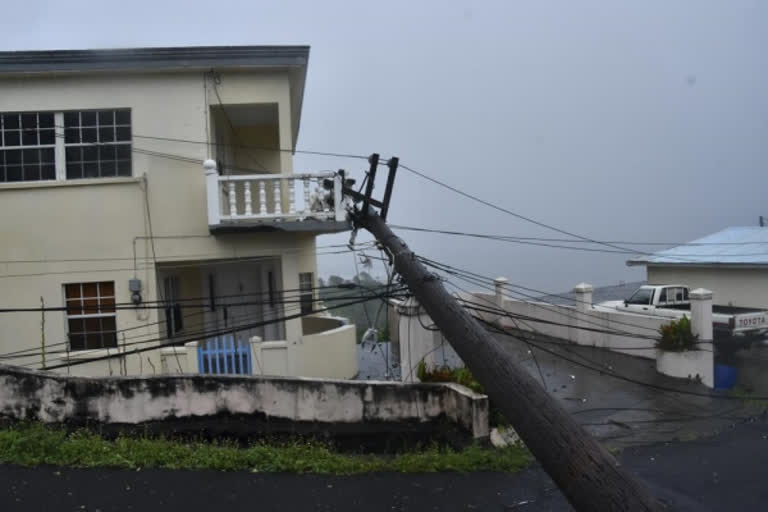Haiti: Tropical Storm Elsa battered the southern coasts of Haiti and the Dominican Republic on Saturday, downing trees and blowing off roofs as it sped through the Caribbean, killing at least three people.
The storm was centered about 175 miles (280 kilometers) east-southeast of Kingston, Jamaica, and was swirling west-northwest at 17 mph (28 kph). It had maximum sustained winds of 65 mph (100 kph) as the tropical storm, which had been a Category 1 hurricane earlier on Saturday, weakened in its approach to Hispaniola and Cuba, according to the National Hurricane Center in Miami.
The storm was forecast to hit Cuba next on a path that would take it to Florida, with some models showing it would spin into the Gulf or up the Atlantic Coast. A tropical storm watch was in effect for the Florida Keys from Craig Key westward to Dry Tortugas. Elsa prompted Gov. Ron DeSantis to declare a state of emergency in 15 Florida counties, including in Miami-Dade County where the high-rise condominium building collapsed last week.
Read: Five injured after building collapses in Washington DC
One death was reported in St. Lucia, according to the Caribbean Disaster Emergency Management Agency. Meanwhile, a 15-year-old boy and a 75-year-old woman died Saturday in separate events in the Dominican Republic after walls collapsed on them, according to a statement from the Emergency Operations Center.
The deaths come a day after Elsa caused widespread damage in several eastern Caribbean islands as a Category 1 hurricane, the first of the Atlantic season. Among the hardest hit was Barbados, where more than 1,100 people reported damaged houses, including 62 homes that completely collapsed as the government promised to find and fund temporary housing to avoid clustering people in shelters amid the pandemic.
Dozens of trees and power lines lay strewn across Barbados, where several schools and government buildings were damaged and hundreds of customers were still without power on Saturday, according to officials. “This is a hurricane that has hit us for the first time in 66 years,” Prime Minister Mia Mottley said Saturday. “There is no doubt this is urgent.”
Barbados suspended classes until Wednesday and expected to reopen its international airport on Sunday. Downed trees also were reported in Haiti, where authorities used social media to alert people about the storm and urged them to evacuate if they lived near water or mountain flanks.
“The whole country is threatened,” the Civil Protection Agency said in a statement. “Make every effort to escape before it’s too late.” Haiti is especially vulnerable to floods and landslides because of widespread erosion and deforestation. In addition, a recent spike in gang violence has forced thousands of people to flee from their homes, so the civil protection agency is running low on basic items including food and water, director Jerry Chandler told The Associated Press.
“It’s been three weeks that we’ve been supporting families who are running away from gang violence,” he said. “We are working at renewing our stocks, but the biggest problem is logistics.” He said officials are still trying to figure out how to deliver supplies to Haiti’s southern region, which braced for Elsa’s impact.
As the storm approached, people kept buying food and water. “I’m protecting myself the best that I can. Civil protection is not going to do that for me,” said Darlene Jean-Pierre, 35, as she bought six jugs of water along with vegetables and fruit. “I have other worries about the street ... I have to worry about gangs fighting. In addition to this, we have a hurricane.”
A tropical storm warning was in effect for Jamaica and from the Haitian capital of Port-au-Prince to the southern border with the Dominican Republic. A hurricane watch was issued for the Cuban provinces of Camaguey, Granma, Guantanamo, Holguin, Las Tunas, and Santiago de Cuba. Some of those provinces have reported a high number of COVID-19 infections, raising concerns that the storm could force large groups of people to seek shelter together.
“Anticipating is the key word,” said Cuban President Miguel Díaz-Canel, adding that vaccination efforts would continue. “Let’s take care of lives and property.”
In the neighboring Dominican Republic, which shares the island of Hispaniola with Haiti, authorities opened more than 2,400 shelters as forecasters warned of heavy rains. Some worried about the state of their homes, with many living under corrugated roofing.
“I have a lot of leaks in my zinc,” said María Ramos. “What are we going to do? Only God knows.” Meanwhile, officials on Saturday reported at least 43 homes and three police stations damaged in St. Vincent and the Grenadines, which also suffered massive volcanic eruptions that began in April.
“We expect that this number will increase as reports keep coming in,” said Prime Minister Ralph Gonsalves. “We have some damage, but it could have been far worse.” In St. Lucia, the wind damaged a secondary school, pummeling desks, overturning chairs and sending papers flying after blowing off the roof and siding.
Read: Families cling to hope as condo collapse toll rises to 9
Elsa was the first hurricane of the Atlantic season and the earliest fifth-named storm on record. Elsa also broke the record as the tropic’s fastest-moving hurricane, clocking in at 31 mph on Saturday morning, according to Brian McNoldy, a hurricane researcher at the University of Miami.
It is forecast to drop 4 to 8 inches (10 to 20 centimeters) of rain with maximum totals of 15 inches (38 centimeters) across portions of southern Hispaniola and Jamaica.
AP



